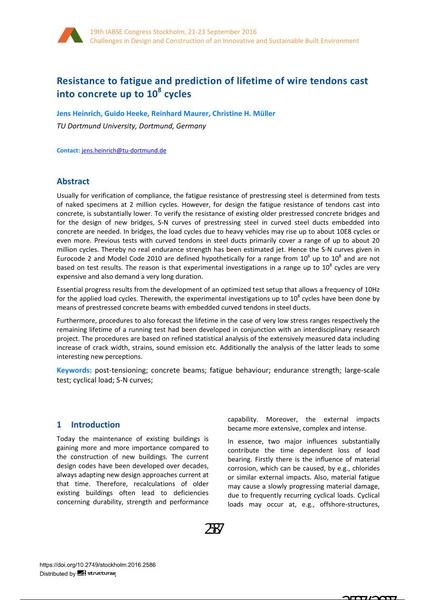Resistance to fatigue and prediction of lifetime of wire tendons cast into concrete up to 108 cycles

|
|
|||||||||||
Bibliografische Angaben
| Autor(en): |
Jens Heinrich
(TU Dortmund University, Dortmund, Germany)
Guido Heeke (TU Dortmund University, Dortmund, Germany) Reinhard Maurer (TU Dortmund University, Dortmund, Germany) Christine Müller (TU Dortmund University, Dortmund, Germany) |
||||
|---|---|---|---|---|---|
| Medium: | Tagungsbeitrag | ||||
| Sprache(n): | Englisch | ||||
| Tagung: | IABSE Congress: Challenges in Design and Construction of an Innovative and Sustainable Built Environment, Stockholm, Sweden, 21-23 September 2016 | ||||
| Veröffentlicht in: | IABSE Congress Stockholm, 2016 | ||||
|
|||||
| Seite(n): | 2587-2599 | ||||
| Anzahl der Seiten (im PDF): | 13 | ||||
| Jahr: | 2016 | ||||
| DOI: | 10.2749/stockholm.2016.2586 | ||||
| Abstrakt: |
Usually for verification of compliance, the fatigue resistance of prestressing steel is determined from tests of naked specimens at 2 million cycles. However, for design the fatigue resistance of tendons cast into concrete, is substantially lower. To verify the resistance of existing older prestressed concrete bridges and for the design of new bridges, S-N curves of prestressing steel in curved steel ducts embedded into concrete are needed. In bridges, the load cycles due to heavy vehicles may rise up to about 10E8 cycles or even more. Previous tests with curved tendons in steel ducts primarily cover a range of up to about 20 million cycles. Thereby no real endurance strength has been estimated jet. Hence the S-N curves given in Eurocode 2 and Model Code 2010 are defined hypothetically for a range from 106 up to 108 and are not based on test results. The reason is that experimental investigations in a range up to 108 cycles are very expensive and also demand a very long duration. Essential progress results from the development of an optimized test setup that allows a frequency of 10Hz for the applied load cycles. Therewith, the experimental investigations up to 108 cycles have been done by means of prestressed concrete beams with embedded curved tendons in steel ducts. Furthermore, procedures to also forecast the lifetime in the case of very low stress ranges respectively the remaining lifetime of a running test had been developed in conjunction with an interdisciplinary research project. The procedures are based on refined statistical analysis of the extensively measured data including increase of crack width, strains, sound emission etc. Additionally the analysis of the latter leads to some interesting new perceptions. |
||||
| Stichwörter: |
Wöhlerlinien Ermüdungsverhalten
|
||||
